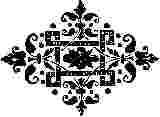
Part IV
The Prophecies of the Old
Testament
In conclusion, we wish to acknowledge our respect for the Old
Testament as the Word of God. However, we must remember that the Old Testament by itself
did not give a clear revealment of God’s purpose. It was full of tantalizing and
wonderful promises, but all very hard to bring into clear focus.
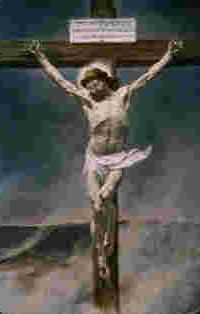
|
It was Jesus who "abolished death" and "brought life and immortality to
light through the Gospel" (2 Timothy 1:10).
We also know that while the "Law was given by Moses," yet
"grace and truth came by Jesus Christ" (John 1:17).
The New Testament did not detract from the Old, though we must realize
the mystery of God was veiled while the prophets spoke.
Further, it was Jesus "who showed us the Father" and made
known to us "exceeding great and precious promises."
|
True, the Old Testament does provide confirmation of
all God’s promises when properly understood; yet, that understanding depends on the
New Testament. It seems a true statement that the "Old Testament is the Word of God
concealed and the New Testament is the Word of God revealed."
Why would Zechariah 4:2, 3 show us the candlestick representing the
church with its seven "lamps" getting its oil from the "two olive
trees" which represent the Old and New Testaments?
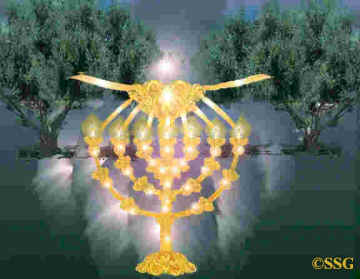
|
In Zechariah 4:14 we are given God’s definition as to what these two olive trees
represent:
"These are the two anointed ones, that stand by the Lord of the
whole earth."
God’s Word is shown as being in two parts, in two olive trees.
|
Why would the second "olive
tree" be left out in Revelation? Certainly, if the Word of God is to be crowned and
enthroned it would include the New Testament as well as the Old. We read in 2 Corinthians
3:7-10:
"If the ministration of death, written and engraven in stones, was
glorious, so that the children of Israel could not steadfastly behold the face of Moses
for the glory of his countenance; which glory was to be done away:
"How shall not the ministration of the spirit be rather glorious?
"For if the ministration of condemnation be glory, much more doth the
ministration of righteousness exceed in glory.
"For even that which was made glorious had no glory in this respect, by
reason of the glory that excelleth."
This is an eloquent statement by Paul to include the glory of the
New Testament.
Also, let us never forget Hebrews 1:1, 2:
"God, who at sundry times and in divers manners spake in time past unto
the fathers by the prophets,
"Hath in these last days spoken unto us by his Son, whom he hath appointed
heir of all things, by whom also he made the worlds."
Again, in Hebrews 2:3:
"How shall we escape, if we neglect so great salvation; which at the first
began to be spoken by the Lord, and was confirmed unto us by them that heard him."
Why, we ask, would the Old Testament prophecies be in such exalted
settings when the still more important point of interest is in a "scroll sealed with
seven seals" until One is found and proved worthy to receive its message from God.
The whole vision centers around the slain Lamb and the "scroll sealed with seven
seals" which contained special revelations God gave to Jesus Christ and which he, in
turn, interpreted and conveyed to the angels of the seven churches.
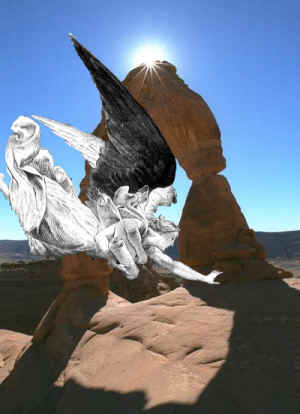
Woman in the Wilderness
Revelation 12:14
|
Another point is that the "woman" of Revelation 12:14 was given "two wings
of a great eagle, that she might fly into the wilderness, into her place, where she is
nourished" for three and one-half times.
You never saw an eagle fly with one wing, did you?
You need both Old and New Testaments.
|
It is the church whom God has chosen to be for
"the praise of his glory." When those twenty-four offices of the "elders,"
are finally filled by the elect church of God, and when that which was foreordained
becomes one with those who are ordained, the "called, chosen and faithful" of
this Gospel age, then another milestone is reached in God’s plan.

Brother Russell’s View
of the Twenty-four Elders
In the
QUESTION BOOK, p. 720, 1912, when Brother
Russell was asked: "What is the meaning of the twenty-four elders which we read about
in the book of Revelations?" "Answer—I think it is in the seventh volume."
Bro. Russell did not give forth much information on this subject.
We believe that his thinking is best summed up in
THE NEW
CREATION, p. 233, already quoted. It shows the "harps" of God are the
Old and New Testaments. Bro. Russell said: "That harp, which when tuned by the holy
Spirit dwelling in our hearts, and swept by the fingers of the devoted servants and
searchers after divine truth, yields the most enchanting strains that ever fell on mortal
ears."
Remember, the twenty-four "elders" have "harps," as
do the 144,000 saints of Revelation
14:1-3, and they play the same song. Things equal to
the same thing are equal to each other.
One last point—perhaps, not of great strength—is that some hymns
portray the saints as "casting down their golden crowns around the glassy sea."
Hymn 165 says, "Till we cast our crowns before Thee, Lost in wonder, love and
praise." More weighty than this, however, is Hymn Appendix B. It was added to our
hymnal in 1916. If ever a hymn would have had to pass under Bro. Russell’s scrutiny,
it is this hymn. It was carefully revised to read in an acceptable manner to Bible
Students.
The hymn is, "Holy, Holy, Holy—Blessed Trinity." It was
revised to: "Holy, Holy, Holy—Blessed Majesty." Notice the words: "All the
saints adore Thee, casting down their golden crowns around the glassy sea."
A quote from Revelation 4:10:
"The four and twenty elders fall down before him that sat on the throne,
and worship him that liveth forever, and cast their crowns before the throne."
Of course, this does not really establish anything, because hymnbook
theology often has a lot of mistakes which we endure under poetic license. If one
holds to a different view on the twenty-four "elders," it shouldn’t
prejudice anyone on Appendix B and Hymn165.

Twenty-two Books of the Bible
—Ernest L. Martin
Leeser suggests the books of the Old Testament add up to
twenty-four. However, Ernest L. Martin, Ph.D., writing in
THE ORIGINAL BIBLE
RESTORED, says, concerning the OT: "These 22 books of the Old
Testament (and their arrangement as indicated) should be the standard followed by every
version of the Bible today."
The arrangement referred to three parts of the Old Testament.
I
THE LAW |
II
THE PROPHETS |
III
THE HOLY WRITINGS |
1 Genesis
2 Exodus
3 Leviticus
4 Numbers
5 Deuteronomy |
6 Joshua
and Judges
7 The Books of Kingdoms
(Samuel & Kings)
8 Isaiah
9 Jeremiah
10 Ezekiel
11 The Twelve
(Hosea to Malachi) |
(Or The
Psalms)
12 Psalms
13 Proverbs
14 Job
15 Songs of Songs
16 Ruth
17 Lamentations
18 Ecclesiastes
19 Esther
20 Daniel
21 Ezra-Nehemiah
22 The Book of Chronicles
|
The Old Testament was divided into three parts by Jesus himself in
Luke 24:44,
"These are the words which I spake unto you, while I was yet with you,
that all things must be fulfilled, which were written in the law of Moses, and in the
prophets, and in the psalms, concerning me."
Dr. Martin says: "The original Scriptures had exactly 49 books:
22 in the Old Testament and 27 in the New. This number is, of course, 7 times 7, and seven
represents the symbolic number of completion or finalization" (p. 13).
7 x 7 gives us 49 which
symbolizes completeness. |
The Book of Jubilees, written by a sect of the Dead Sea community in
Jubilees 2:23, says: "God made 22 things on the six days of creation. These 22 events
paralleled the 22 generations from Adam to Jacob, the 22 letters of the Hebrew alphabet,
and the 22 books of the Holy Scriptures."
Twenty-two church fathers from Melito (170 A.D.) to Richard of St.
Victor (13th century) all confirmed twenty-two books for the OT. However, more
importantly, we have a biblical basis for twenty-two books to the Old Testament.
In Exodus 25:33, 34 we read concerning the candlestick:
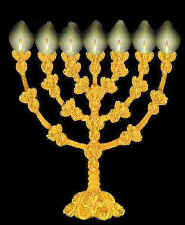
|
"Three
bowls made like unto almonds, with a knop and a flower in one branch; and three bowls made
like almonds in the other branch, with a knop and a flower: so in the six branches that
come of the candlestick.
"And in the
candlestick shall be four bowls made like unto almonds, with their knops and their
flowers." |
There are three bowls, knops and flowers on each of
six branches with four bowls, knops and flowers on the main stem. This is a total of
twenty-two each. What does this mean? Might this not confirm the twenty-two books of the
Old Testament? Interestingly, if we add up the total number of bowls, knops and flowers we
have sixty-six, the number of books
in the Bible.
Sometime in the last part of the first century or the beginning of
the second, the Jewish authorities decided to re-divide the books of the Old Testament
into twenty-four. The Jews in Babylon were the first to devise this new number.
Sixtus Senensis gave the explanation for the change from 22 to 24 as
follows: "Since there was only one yodh among the 22 letters, and because the
Jews started a peculiar habit of writing the unpronounceable name YHWH with three yodhs,
it was necessary, so Sixtus tells us, to renumber the Old Testament books by
the addition of two extra yodhs."
This was an artificial literary device and could hardly have any
relevance to the original numbering of the books of the Old Testament. By numbering the
Bible into 66 (39 + 27) books, by each book being counted separately, we see the number
six plainly and emphatically denotes it to be a human book in human dress.
Jewish authorities could well see that 22 Old Testament and 27 New
Testament books would make a total of forty-nine, a complete divine revelation. By
changing to a 24 Old Testament standard, that gave the 24 and 27 an insignificant 51 which
would tend to discredit the New Testament.
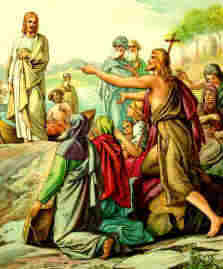
John the Baptist |
Jesus says in Luke 16:16: "The law and the prophets were until John."
This makes John one of the last of the prophets and from Jesus own
words also the greatest or at least among the greatest. "There has risen no one
greater than John the Baptist."
(Matthew 11:11, ESV)
However, John the Baptist does not have a book to bear his name. He was
a prophet, and one of the greatest, but not listed in the Old Testament, only the New.
|
Hence, twenty-four courses of the priesthood are the
only biblical twenty-four we have to match the twenty-four "elders" of
Revelation. It is our thought that the four and twenty elders of Revelation are the
twenty-four foreordained courses of the Priesthood, designated before the Temple is
complete and operational.
When the temple is complete, then we would change the word foreordained
to ordained, for the personhood of the saints then will be added to the twenty-four
offices, twenty-four thrones with their twenty-four crowns.